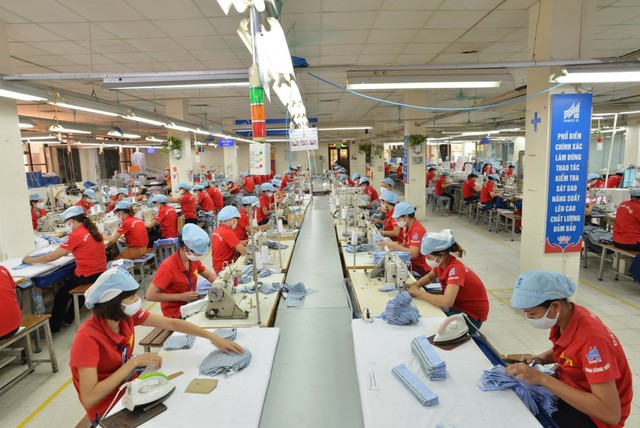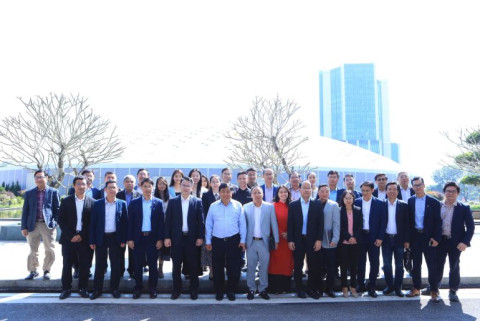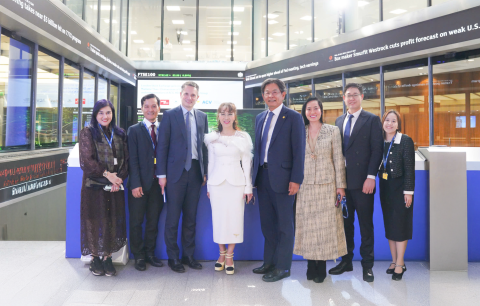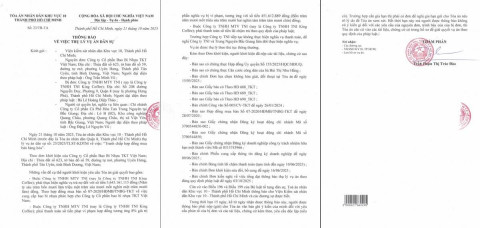What Obstacles Will the Vietnamese Textile Industry Face in 2024?
- 590
- Business
- 21:38 25/01/2024
DNHN - 2024 promises to be a challenging year for the textile industry, despite its significant growth in the past. However, the textile industry is currently highly unpredictable, forcing businesses in this sector to take short-term and long-term measures.

Challenges faced by textile and garment businesses
Currently, the Vietnamese textile and garment industry faces strong competition from other countries in the region and globally. China, India, and Southeast Asian countries are all increasing their textile production and export capacity. To compete, Vietnam needs to increase productivity, improve quality, and innovate technology to reduce production costs.
Despite having a large labour force, the Vietnamese textile and garment industry is facing a shortage of skilled labour. To meet market demands and advanced technology, significant investment in training and human resource development is required. Establishing vocational training programs, and collaborating with universities and research institutes will help provide skilled labour that meets the industry’s requirements.
Furthermore, the textile market is shifting from low-priced products to products with higher added value. Customers increasingly demand high quality, unique designs, and sustainability. To meet this demand, the Vietnamese textile industry needs to enhance its design capabilities, strengthen product research and development, and adopt high-quality standards.
At present, the Vietnamese textile and garment industry heavily relies on the supply of raw materials from foreign countries. The instability in the supply of raw materials can significantly affect the production and export process. Establishing a stable domestic raw material supply system and finding reliable supply partners in the international market is a significant challenge that textile businesses need to overcome.
In addition, the textile and garment industry is an industry that consumes a lot of energy and natural resources. Facing climate change and increasing pressure to protect the environment, the Vietnamese textile industry needs to focus on sustainable solutions, such as using renewable energy sources, minimising waste, and treating wastewater effectively.
To overcome these challenges, the Vietnamese textile industry needs to focus on investing in technology upgrades, innovation, and improving labour productivity. At the same time, it is necessary to establish training and human resource development programs to meet market demands. More importantly, the industry needs to build close cooperative relationships with partners in the supply chain and seek international cooperation opportunities to enhance competitiveness.

2024 is predicted to be “uncertain”, with many potential risks
Mr Le Tien Truong - Chairman of the Board of Directors of Vinatex commented that in 2024, both the International Monetary Fund (IMF) and Chartered Bank have predicted that the Euro, British Pound, and Japanese Yen will all appreciate against the US Dollar. In that context, the Vietnamese Dong is also unlikely to depreciate sharply against the US Dollar. It is predicted that the US textile market could grow by 8-10% in demand.
Mr Truong said that the overall demand tends to improve compared to 2023, but there are still many uncertainties depending on market developments in the US, Europe, China, and Japan. With the level of business improvement in the fourth quarter and the rapid inventory reduction, Mr Truong said “There is hope that orders for the garment industry will soon return”.
Meanwhile, Mr Cao Huu Hieu - General Director of the Vietnam National Textile and Garment Group (Vinatex) assessed that if 2023 was a year of “instability” due to political and economic factors, 2024 is predicted to be a year of “uncertainty”, with many potential risks. The contrasting views of major research organisations suggest that 2024 will be a completely unpredictable year with many negative and positive factors intertwined. Meanwhile, Vietnam’s textile industry is one of the leading export industries, with exports accounting for more than 80% of the total production value of the entire industry. Therefore, it is also the industry most directly and severely affected by the world’s economic, political, and social situation. The total demand for textiles and garments worldwide in 2024 is expected to reach 715 billion USD, a slight increase compared to 2023 but still lower than in 2022, only equal to the level of 2020 when COVID-19 occurred, indicating that 2024 will not be a very promising year.
The General Director of Vinatex said that in the face of uncertain market forecasts for 2024, the Vietnamese textile industry needs to focus on market work. Because the decrease in demand will certainly lead to high competition in winning orders, market work is therefore a top priority. In particular, it is necessary to strengthen the staff doing market work, build a thorough strategy in determining product segments, developing new markets and customers. In addition to long-term directional forecasts, it is necessary to strengthen short-term forecasts to respond quickly to market fluctuations.
In addition, according to Mr Hieu, textile businesses need to “find a breakthrough” because the secret to the success of any business lies in its ability to identify and anticipate trends. If businesses can identify their “breakthrough”, whether it is a new product, a new market, a new customer, etc., they need to act decisively and quickly to be able to quickly excel.
Thus, 2024 marks an important stage for the Vietnamese textile industry. By facing and overcoming these challenges, the industry can continue to grow and contribute to the economic prosperity of the country.
Nghe Nhan
Related news
- From New Year messages of World Leaders to the “new rules” of the Global economy in 2026
- Connecting Leaders, Shaping the Future: Strategic Leadership Planning Meeting – CorporateConnections Hanoi A
- Sunlight - Unilever Vietnam Recognized for Outstanding Contributions to the National Initiative Supporting Women Entrepreneurs
- Deputy Prime Minister Nguyễn Chí Dũng: “The country’s major challenges weigh heavily on my mind — and we must resolve them together.
- Unitsky String Technologies signs cooperation agreements with three Vietnamese partners, opening a new direction for smart mobility and sustainable development
- When artists do business – livelihood is no poetry!
- Before the D‑day to abolish flat‑rate tax: Fear of technology and costs leave small traders struggling to adapt
- Vietnamese enterprises at a crossroads: the impact of a potential US–China deal
- "Digital technicians" must not be forgotten if Vietnam aims to meet its strategic goals
- HDBank: Impressive profit growth, leading in profitability and advancing international integration
- TNI King Coffee sued for over VND 5 Billion in unpaid debts
- VINASME and Jeonnam Technopark Sign MOU on technology cooperation, human resource training, and trade promotion
- Vietnamese entrepreneurs strengthen ASEAN connectivity in the digital iIntegration era
- Prime Minister: Vietnam aims to become a regional logistics hub
- Vietnam upgraded to Secondary Emerging Market by FTSE Russell
- Hanoi’s economy grows 7.92% in first nine months of 2025, FDI surges nearly threefold
- Vietnam’s strong gdp growth fails to ease labor market distress
- US tariffs on Brazil propel Vietnam’s pangasius into global spotlight
- VietLeap AI Accelerator launches: A strategic springboard for Vietnam’s AI startups
- CICON expands strategic alliances: A new step forward in Vietnam–Korea business connectivity
Đọc thêm Business
From New Year messages of World Leaders to the “new rules” of the Global economy in 2026
At a pivotal moment of transition, New Year messages from capitals such as Hanoi, Beijing, Washington and Paris reflect distinct priorities and strategic visions.
Connecting Leaders, Shaping the Future: Strategic Leadership Planning Meeting – CorporateConnections Hanoi A
"Your network is your most powerful flowing asset. It generates value, multiplies opportunities, and accelerates your influence across borders."
Innovative ESG enterprise: Trạm Xe Việt startup proposes solutions to build a green mobility ecosystem
As Vietnam commits to achieving Net Zero by 2050 and tightens emissions standards, the transportation sector faces unprecedented pressure to transform.
Deputy Prime Minister Nguyễn Chí Dũng: “The country’s major challenges weigh heavily on my mind — and we must resolve them together.
On the morning of November 26, 2025, Deputy Prime Minister Nguyễn Chí Dũng chaired a high-level working session at the National Innovation Center (NIC) in Hòa Lạc.
Unitsky String Technologies signs cooperation agreements with three Vietnamese partners, opening a new direction for smart mobility and sustainable development
The signing ceremony took place in Minsk, Belarus, on November 28, 2025.
Before the D‑day to abolish flat‑rate tax: Fear of technology and costs leave small traders struggling to adapt
From 1 January 2026 the flat‑rate tax regime will be abolished. Small business households will be required to declare tax based on actual revenue. MISA supports the transition with technology to help micro‑merchants adapt smoothly and transparently.
Vietnamese enterprises at a crossroads: the impact of a potential US–China deal
As the world closely monitors every shift in US-China relations, emerging signals of a strategic agreement between the two global powers are raising hopes for global economic stability.
HDBank: Impressive profit growth, leading in profitability and advancing international integration
Ho Chi Minh City Development Joint Stock Commercial Bank (HDBank, stock code HDB) announced its consolidated profit before tax for the first 9 months of 2025 reached VND 14,803 billion, marking a 17% increase year-on-year (YoY).
TNI King Coffee sued for over VND 5 Billion in unpaid debts
On October 21, 2025, the People’s Court of District 10 in Ho Chi Minh City officially accepted a civil lawsuit concerning a commercial contract dispute between TKT Vietnam Plastic Packaging Joint Stock Company and TNI King Coffee Co., Ltd.
VINASME and Jeonnam Technopark Sign MOU on technology cooperation, human resource training, and trade promotion
On October 15, 2025, in Hanoi, VINASME and Jeonnam Technopark (Korea) signed an MOU to promote trade, advance technology transfer, and develop human resources between enterprises of both nations.











